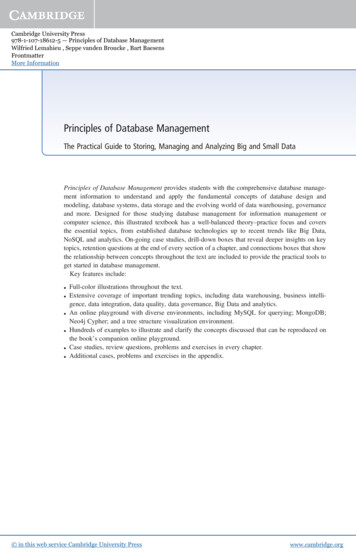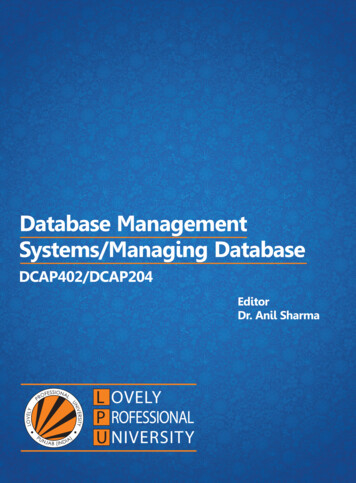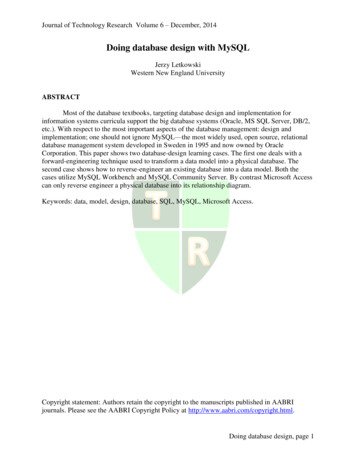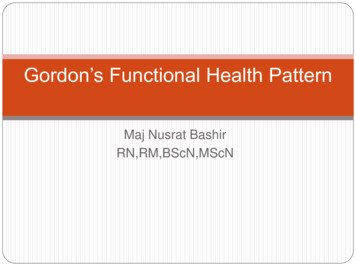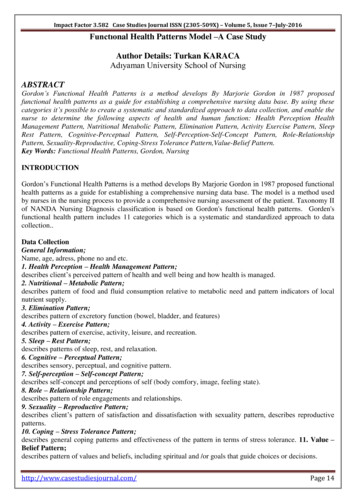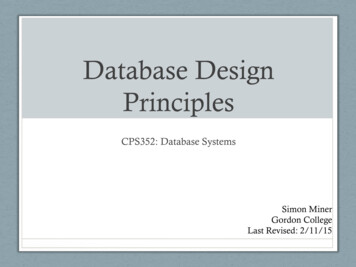
Transcription
Database DesignPrinciplesCPS352: Database SystemsSimon MinerGordon CollegeLast Revised: 2/11/15
Agenda Check-in Design Project ERD Presentations Database Design Principles DecompositionFunctional DependenciesClosuresCanonical Cover Homework 3
Check-in
The Entities and Relationships of the PsalmsPsalm 30, 31, and 32 (NIV)
Some Assertions about PsalmData Each psalm is identified by a number, has a text, andmay have a type, recipient, and zero or more instruments An author is identified by a name and has aposition. An author may write multiple psalms, butevery author must be associated with at least one psalm. An occasion is identified by a name and has alocation. A single psalm can be used for multipleoccasions, but it doesn’t make sense to have an occasionwithout a psalm. (How boring would that be!) A psalm can describe one or more acts of God, andmultiple psalms can describe a single act of God.
Design Project ERDPresentationsMilestone II
Database DesignPrinciples
Introduction Terminology review Relation scheme – set of attributes for some relation (R, R1, R2) Relation – the actual data stored in some relation scheme (r, r1, r2) Tuple – a single actual row in the relation (t, t1, t2) Changes to the library database schema We make the following updates for this discussion Add the following attributes to the book relation copy number – a library can have multiple copies of a book accession number – unique number (ID) assigned to a copy of a book whenthe library acquires it New book and checked out relation scheme Book( call number, copy number, accession number, title, author ) Checked out( borrower id, call number, copy number, date due )
The Art of Database Design Designing a database is a balancing act On the one extreme, you can have a universal relation (in which allattributes reside within a single relation scheme) Everything(borrower id, last name, first name, // from borrowercall number, copy number,accession number, title, author// from bookdate due// from checked out) Leads to numerous anomalies with changing data in the database
Break Up Relations withDecomposition Decomposition is the process of breaking up an originalscheme into two or more schemes Each attribute of the original scheme appears in at least oneof the new schemes But this can be taken too far Borrower( borrower id, last name, first name ) Book( call number, copy number, accession number, title,author ) Checked out( date due ) Leads to lossy-join problems
We Want Lossless-JoinDecompositions Part of the middle ground in the balancing act Allows decomposition of the Everything relation Preserves connections between the tuples of the participatingrelations So that the natural join of the new relations the originalEverything relation Formal definition For some relation scheme R decomposed into two or moreschemes (R1, R2, Rn) Where R R1 R2 Rn A lossless-join decomposition means that for every legal instancer of R decomposed into r1, r2, rn of R1, R2, and Rn r r1 X r2 X X rn
Database Design Goal: Create“Good” Relations We want to be able to determine whether a particularrelation R is in “good” form. We’ll talk about how to do this shortly In the case that a relation R is not in “good” form,decompose it into a set of relations {R1, R2, ., Rn} suchthat each relation is in good form the decomposition is a lossless-join decomposition Our theory is based on: functional dependencies multivalued dependencies
Functional Dependency (FD) When the value of a certain set of attributes uniquelydetermines the value for another set of attributes Generalization of the notion of a key A way to find “good” relations A B (read: A determines B) Formal definition For some relation scheme R and attribute sets A (A R) andB (B R) A B if for any legal relation on R If there are two tuples t1 and t2 such that t1(A) t2(A) It must be the case that t2(B) t2(B)
Finding FunctionalDependencies From keys of an entity From relationships between entities Implied functional dependencies
FDs from Entity KeysA BC
FDs from One to Many /Many to One RelationshipsA BCW XYA BCMWXY
FDs from One to OneRelationshipsA BCW XYA BCMWXYW XYMABC
FDs from Many to ManyRelationshipsA BCW XYAW M
Implied FunctionalDependencies Initial set of FDs logically implies other FDs If A B and B C, then A C Closure If F is the set of functional dependencies we developfrom the logic of the underlying reality Then F (the transitive closure of F) is the set consistingof all the dependencies of F, plus all the dependenciesthey imply
Rules for Computing F We can find F , the closure of F, by repeatedly applyingArmstrong’s Axioms: if , then (reflexivity) Trivial dependency if , then if , and , then (augmentation)(transitivity) Additional rules (inferred from Armstrong’s Axioms) If and , then (union) If , then and (decomposition) If and , then (pseudotransitivity)
Applying the Axioms R (A, B, C, G, H, I)F { A BA CCG HCG IB H} some members of F A H by transitivity from A B and B H AG I by augmenting A C with G, to get AG CGand then transitivity with CG I CG HI by augmenting CG I to infer CG CGI,and augmenting of CG H to infer CGI HI,and then transitivity or by the union rule
Algorithm to Compute F To compute the closure of a set of functionaldependencies F:F Frepeatfor each functional dependency f in F apply reflexivity and augmentation rules on fadd the resulting functional dependencies to F for each pair of functional dependencies f1and f2 in F if f1 and f2 can be combined using transitivitythen add the resulting functionaldependency to F until F does not change any further
Algorithm to Compute theClosure of Attribute Sets Given a set of attributes , define the closure of under F(denoted by ) as the set of attributes that arefunctionally determined by under F Algorithm to compute , the closure of under Fresult : ;while (changes to result) dofor each in F dobeginif result then result : result end
Example of Attribute SetClosure R (A, B, C, G, H, I) F {A BA CCG HCG IB H} (AG) 1.2.3.4. result AGresult ABCGresult ABCGHresult ABCGHI(A C and A B)(CG H and CG AGBC)(CG I and CG AGBCH)Is AG a candidate key?1. Is AG a super key?1. Does AG R? Is (AG) R2. Is any subset of AG a superkey?1. Does A R? Is (A) R2. Does G R? Is (G) R
Canonical Cover Sets of functional dependencies may have redundantdependencies that can be inferred from the others For example: A C is redundant in: {A B, B C, A C} Parts of a functional dependency may be redundant E.g.: on RHS: {A B, B C, A CD} can be simplified to{A B, B C, A D} E.g.: on LHS: {A B, B C, AC D} can be simplified to{A B, B C, A D} Intuitively, a canonical cover of F is a “minimal” set offunctional dependencies equivalent to F, having no redundantdependencies or redundant parts of dependencies
Definition of Canonical Cover A canonical cover for F is a set of dependencies Fc such that F logically implies all dependencies in Fc, andFc logically implies all dependencies in F, andNo functional dependency in Fc contains an extraneous attribute, andEach left side of functional dependency in Fc is unique. To compute a canonical cover for F:repeatUse the union rule to replace any dependencies in F 1 1 and 1 2 with 1 1 2Find a functional dependency with anextraneous attribute either in or in /* Note: test for extraneous attributes done using Fc, not F*/If an extraneous attribute is found, delete it from until F does not change Note: Union rule may become applicable after some extraneous attributeshave been deleted, so it has to be re-applied
How to Find a CanonicalCover Another algorithm Write F as a set of dependencies where each has asingle attribute on the right hand side Eliminate trivial dependencies In which and (reflexivity) Eliminate redundant dependencies (implied by otherdependencies) Combine dependencies with the same left hand side For any given set of FDs, the canonical cover is notnecessarily unique
Uses of FunctionalDependencies Testing for lossless-join decomposition Testing for dependency preserving decompositions Defining keys
Testing for Lossless-JoinDecomposition The closure of a set of FDs can be used to test if adecomposition is lossless-join For the case of R (R1, R2), we require that for allpossible relations r on schema Rr R1 (r ) R2 (r ) A decomposition of R into R1 and R2 is lossless join if atleast one of the following dependencies is in F : R1 R2 R1 R1 R2 R2 Does the intersection of the decomposition satisfy at leastone FD?
Testing for DependencyPreserving Decompositions The closure of a set of FDs allows us to test a new tuple beinginserted into a table to see if it satisfies all relevant FDs withouthaving to do a join This is desirable because joins are expensive Let Fi be the set of dependencies F that include onlyattributes in Ri. A decomposition is dependency preserving, if(F1 F2 Fn ) F If it is not, then checking updates for violation of functionaldependencies may require computing joins, which is expensive. The closure of a dependency preserving decomposition equalsthe closure of the original set Can all FDs be tested (either directly or by implication) withoutdoing a join?
Keys and FunctionalDependencies Given a relation scheme R with attribute set K R K is a superkey if K R K is a candidate key if there is no subset L of K such that L R A superkey with one attribute is always a candidate key Primary key is the candidate key K chosen by the designer Every relation must have a superkey (possibly the entireset of attributes) Key attribute – an attribute that is or is part of a candidatekey
Homework 3
The Art of Database Design Designing a database is a balancing act On the one extreme, you can have a universal relation (in which all attributes reside within a single relation scheme) Everything( borrower_id, last_name, first_name, // from borrower call_number,





